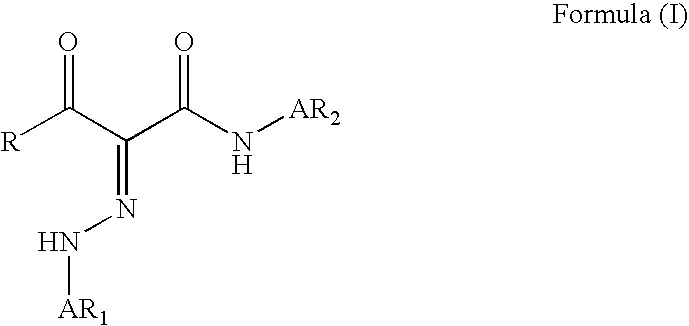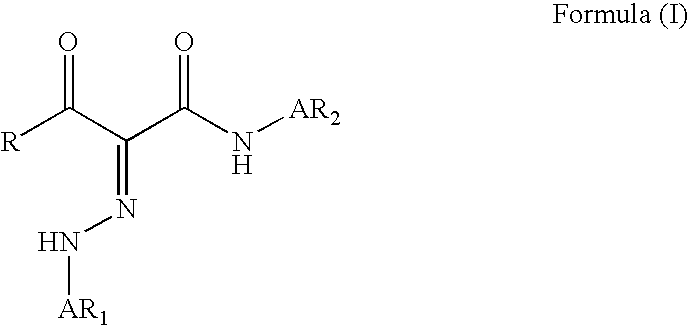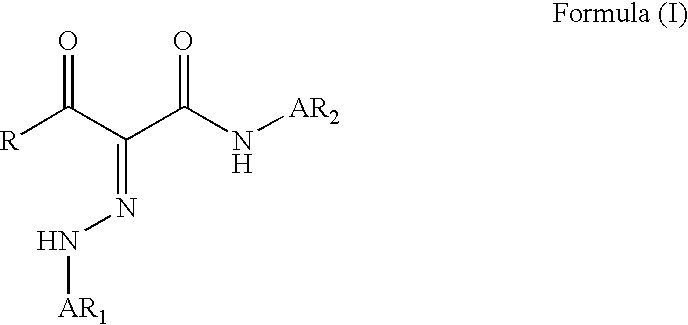Non-Aqueous Pigment Dispersions Containing Specific Dispersion Synergists
a technology of specific dispersion and pigment, which is applied in the field of stable pigment dispersions and pigmented inkjet inks, can solve the problems of difficult preparation of good thermally stable dispersions with submicron particles, pigments are particularly difficult to disperse, and dispersed pigment particles may have a tendency to re-agglomerate, etc., and achieves high dispersion stability
- Summary
- Abstract
- Description
- Claims
- Application Information
AI Technical Summary
Benefits of technology
Problems solved by technology
Method used
Image
Examples
example 1
[0212]This example illustrates that non-aqueous inkjet inks with high dispersion quality for producing high image quality are obtained when using dispersion synergists having at least one carboxylic acid group compared to dispersion synergists lacking a carboxylic acid group and / or the anionic part of the dispersion synergist being larger than the pigment.
Comparative Synergists
Dispersion Synergist SYN-A
[0213]The anionic part of the commercially available dispersion synergist SYN-A can be represented by:
[0214]The anionic part of SYN-A has a molecular weight of 786 and consists of 78 atoms.
Dispersion Synergist SYN-B
[0215]The dispersion synergist SYN-B is the analogue of dispersion synergist SYN-27 but containing a sulphonic acid group instead of a carboxylic acid group.
Synthesis of SYN-B:
[0216]First, a compound 24 was prepared according to the following synthesis scheme:
17.3 g (0.1 mol) of compound 7 in 150 mL water was dissolved by adding 10 mL (0.1 mol) of a 29% sodiumhydroxide-solu...
example 2
[0233]This example illustrates the improvement in dispersion stability
Preparation of InkJet Inks
[0234]All inkjet inks were prepared in the same manner as in EXAMPLE 1 to obtain a composition as described in Table 4, except that different pigments and dispersion synergists were used. In some examples, the ratio of polymeric dispersant over dispersion synergist was altered through replacement or addition of the organic solvent DEGDEE.
[0235]Using the above method, the comparative inkjet inks COMP-1 to COMP-3, COMP-14 and COMP-15 and the inventive inkjet inks INV-1, INV-4, INV-6, INV-9, INV-10, INV-11, INV-13 to INV-19 were prepared according to Table 6. The value for % synergist indicates how much dispersion synergist was used in wt % based on the polymeric dispersant.
TABLE 6Loss inSSFSSFSynergist(no heatafterSamplePigmentType%% MWtreatment)7 d / 80° C.COMP-1PY120None 0%—4835%COMP-2PY155None 0%—4342%COMP-3PY180None 0%—10847%COMP-14PY120SYN-2910%107% 7047%COMP-15PY120SYN-B10%105% 4558%INV...
example 3
[0237]This example illustrates the synthesis methods used for preparing the dispersion synergists used in EXAMPLES 1 and 2.
Dispersion Synergist SYN-7
[0238]Formation of the dispersion synergist SYN-7 was accomplished by diazotation of compound 4 and subsequent coupling with compound 3 according to the following synthesis scheme:
13.7 g (0.1 mol) of compound 4 in 300 mL water was dissolved by adding 10 mL (0.1 mol) of a 29% sodiumhydroxide-solution. 8.97 g (0.13 mol) of sodiumnitrite was added and the colorless solution was dropwise added to cooled concentrated hydrochloric acid (29.98 mL; 0.36 mol). The diazonium-salt was kept at a temperature between 0 and 5° C. After 15 minutes the excess of nitrite was neutralized by adding 3.0 g (0.03 mol) of sulfamic acid and a pH of 7 was obtained by adding 25.2 g (0.3 mol) of sodiumcarbonate. While the diazionium-salt was made, 23.3 g (0.1 mol) of compound 3 was dissolved in a mixture of 500 mL methanol and 10.0 mL (0.1 mol) 29% sodiumhydroxide...
PUM
| Property | Measurement | Unit |
|---|---|---|
| Fraction | aaaaa | aaaaa |
| Temperature | aaaaa | aaaaa |
| Temperature | aaaaa | aaaaa |
Abstract
Description
Claims
Application Information
 Login to View More
Login to View More - R&D
- Intellectual Property
- Life Sciences
- Materials
- Tech Scout
- Unparalleled Data Quality
- Higher Quality Content
- 60% Fewer Hallucinations
Browse by: Latest US Patents, China's latest patents, Technical Efficacy Thesaurus, Application Domain, Technology Topic, Popular Technical Reports.
© 2025 PatSnap. All rights reserved.Legal|Privacy policy|Modern Slavery Act Transparency Statement|Sitemap|About US| Contact US: help@patsnap.com



